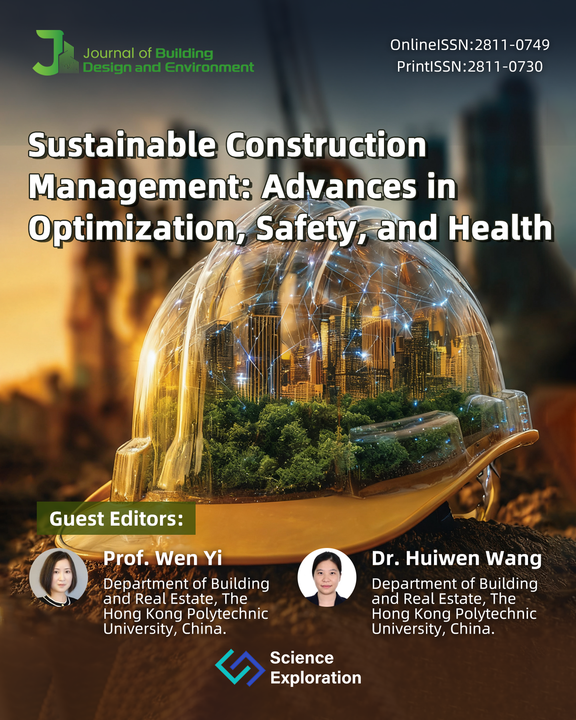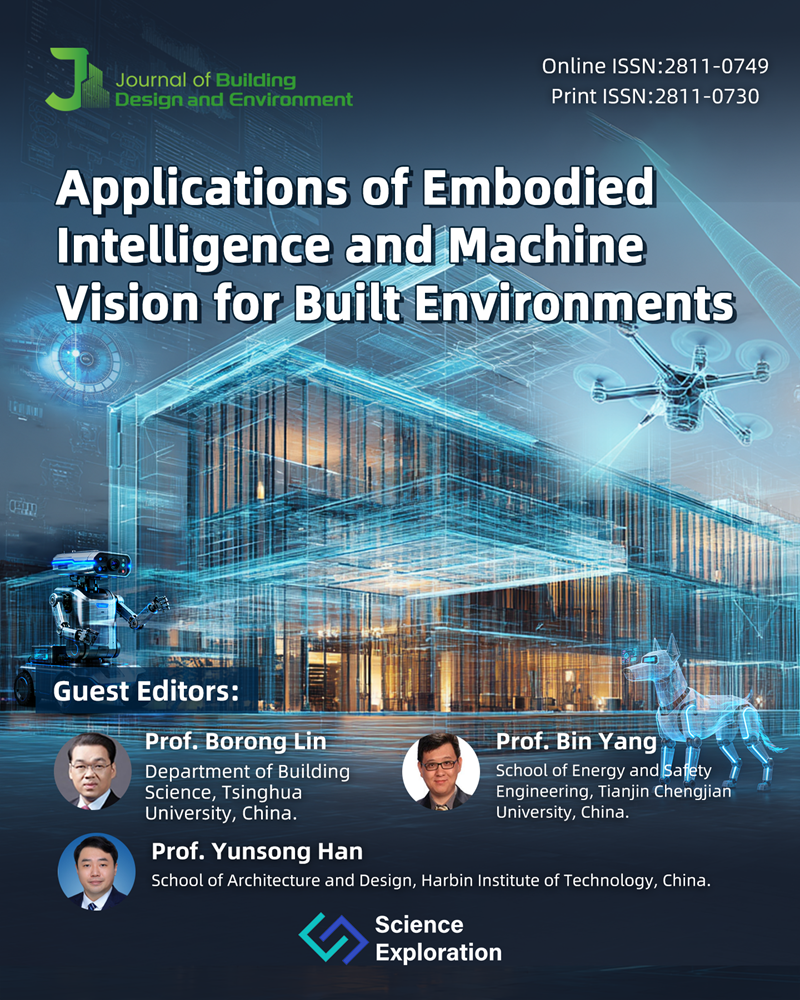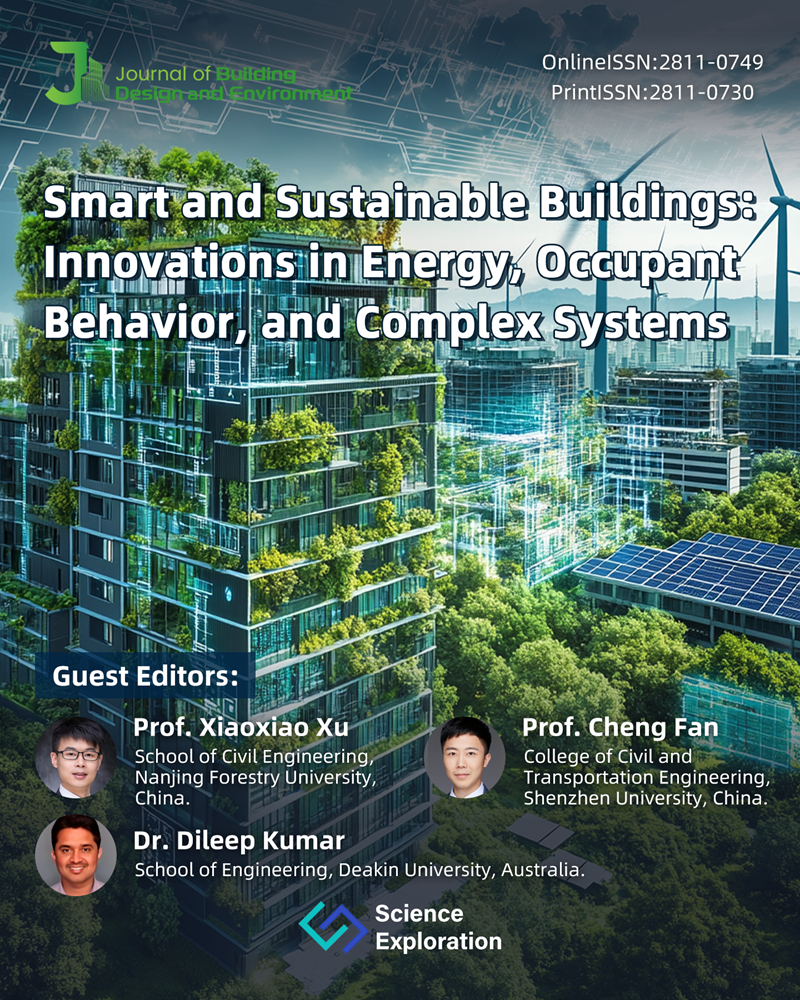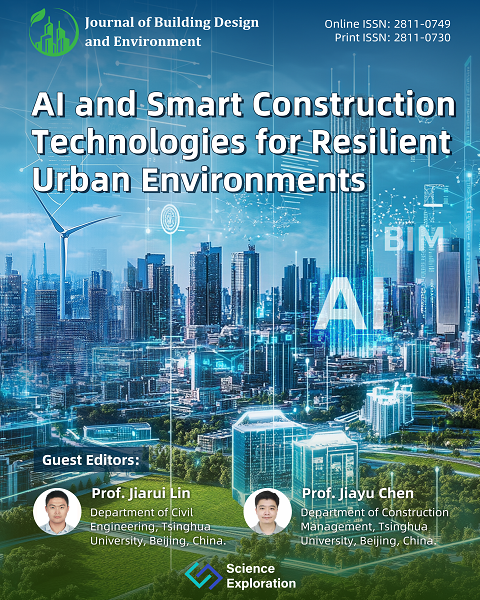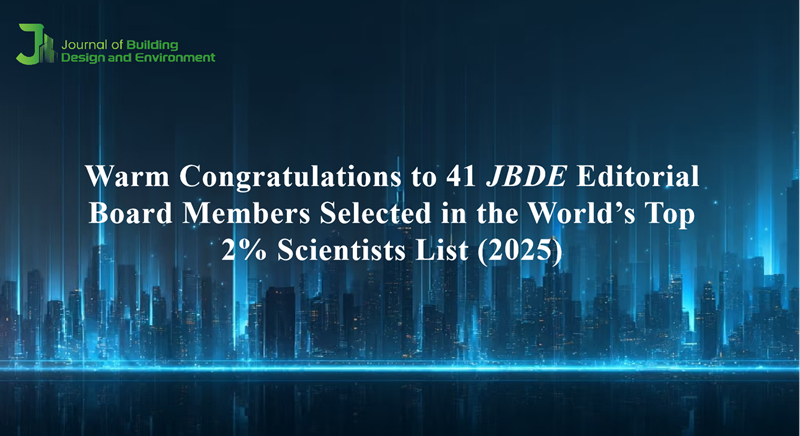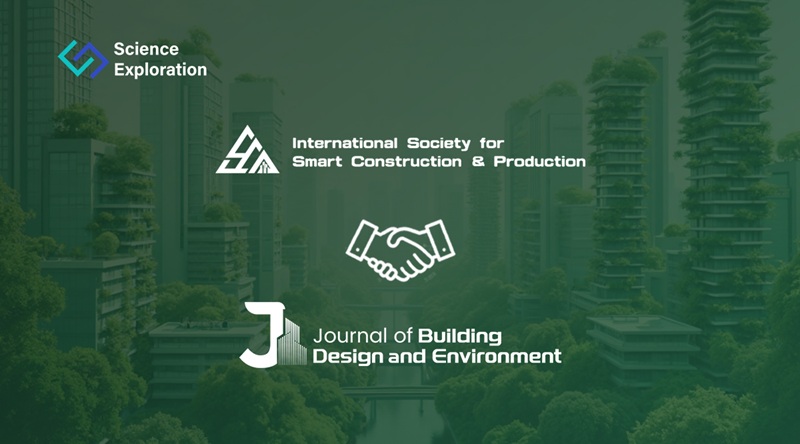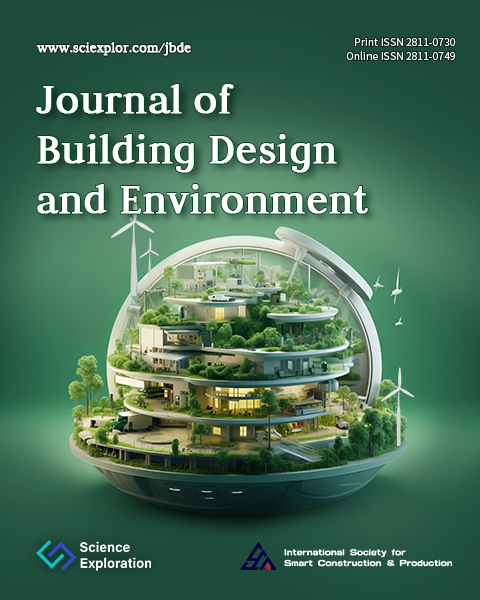
-
Journal of Building Design and Environment (JBDE, Print ISSN 2811-0730; Online ISSN 2811-0749) is a peer-reviewed, open-access journal, published triannually and owned by Science Exploration Press (from Volume 2 Issue 3, 2024). Focusing on ecological architectural design, JBDE integrates architectural engineering, architectural aesthetics, sustainable development, and urban planning. more >
Articles
Enhancing the shear properties of U-Shaped steel wire mesh reinforced 3D printed composites
-
3D-printed concrete (3DPC) represents a rapidly developing technology with numerous applications in construction. The properties of 3DPC under both static and dynamic loads can be enhanced by incorporating reinforcement. This study presents a novel reinforcement ...
More3D-printed concrete (3DPC) represents a rapidly developing technology with numerous applications in construction. The properties of 3DPC under both static and dynamic loads can be enhanced by incorporating reinforcement. This study presents a novel reinforcement technique utilizing U-shaped steel wire mesh (U-shape SWM). This technique involves integrating both horizontal and vertical reinforcements during the concrete printing process. Additionally, a new fabrication process was developed using a dual-arm robotic system, with each arm equipped with shaping and welding tools, to autonomously create U-shape SWM structures. An experimental investigation was conducted on specimens reinforced with either flat or U-shape SWM reinforcements under flexural loading. Compared to the specimens reinforced with a single layer of 6-mm flat SWM under a shear-span ratio of 2, those incorporating one layer of U-shape SWM combined with two layers of 6-mm flat mesh exhibited a 200% increase in failure load and a 26.09% increase in cracking load, while the ultimate displacement decreased by approximately 6%. Under a reduced shear-span ratio of 0.5, this reinforcement configuration reached a failure load of 43.6 kN, a cracking load of 16.1 kN, and an ultimate displacement of 11.1 mm. Furthermore, an analytical model based on the strut-tie model was developed to predict the load-bearing capacity of the reinforced specimens. The model predictions showed good correspondence with the experimental results.
Less -
Genbao Zhang, ... Yufei Wang
-
DOI: https://doi.org/10.70401/jbde.2025.0020 - December 16, 2025
-
This article belongs to the Special Issue Advances in Construction Materials, Structures and Geotechnical Engineering
Automated approach for indoor geometric quality inspection data collection based on BIM and quadruped robot equipped with LiDAR
-
Indoor geometric quality inspection plays a crucial role in construction quality control. Light detection and ranging (LiDAR) can obtain point cloud data of the indoor environments in full range, which then can be utilized to efficiently extract geometric ...
MoreIndoor geometric quality inspection plays a crucial role in construction quality control. Light detection and ranging (LiDAR) can obtain point cloud data of the indoor environments in full range, which then can be utilized to efficiently extract geometric features of building elements for inspection. However, existing data collection of indoor environments using LiDAR is still manually planned and implemented, which is quite time-consuming as the scanning space is usually unknown and the movability of equipment is limited. Therefore, this paper proposes an automated approach for indoor geometric quality inspection data collection based on Building Information Model (BIM) and quadruped robot equipped with LiDAR. First, BIM with accurate geometric and semantic information of building is integrated with heuristic algorithm to automate scan planning, including scan stations and order. Second, Simultaneous Localization and Mapping (SLAM) integrates with BIM is equipped into a quadruped robot to achieve automated data collection capability. Finally, an intelligent execution module for scanning point cloud data in indoor environments is introduced. The proposed approach is validated in real indoor environments. Compared with traditional data collection methods, the experiment results show that the proposed approach can save 42% of scanning time, and the scanned point cloud data has better quality and enough density, which significantly improves the efficiency of inspection data collection for indoor geometric quality management. By unifying BIM-driven planning, SLAM-based localization, and quadruped robot mobility into a single framework, this study introduces a novel approach for large-scale automated indoor inspection, with attention to connected areas to ensure continuity across multiple spaces.
Less -
Yi Tan, ... Qian Wang
-
DOI: https://doi.org/10.70401/jbde.2025.0019 - November 18, 2025
-
This article belongs to the Special Issue BIM-Driven Intelligent Construction and Operation
A multi-agent debate workflow for construction projects: A cross-stage decision framework
-
The growing complexity of construction projects demands decision processes that can integrate diverse professional perspectives across design, cost control, construction, and acceptance. Traditional sequential management approaches often leave conflicts ...
MoreThe growing complexity of construction projects demands decision processes that can integrate diverse professional perspectives across design, cost control, construction, and acceptance. Traditional sequential management approaches often leave conflicts unresolved until late stages, causing delays, cost overruns, and rework. To address this issue, this study develops a cross-stage workflow for construction projects that embeds artificial intelligence into collaborative decision-making. The workflow employs digital agents representing different roles, which engage in structured debates supported by evidence from building information modeling models, engineering drawings, cost records, and technical standards. Through iterative exchanges, alternative solutions are proposed, challenged, and refined, with the process producing decisions that are transparent, traceable, and adaptable to changing project conditions. Results from four representative scenarios confirm significant improvements over conventional practice: unresolved design clashes were reduced by more than 40%, cost forecast deviations narrowed from around 12% to below 5%, schedule variance under disruption decreased by about 18%, and first-pass acceptance rates increased from 74% to 88% with fewer reworks. A longer-term case study further demonstrated reductions in cost variance and project duration, together with higher stakeholder satisfaction. By coupling AI-enabled debate mechanisms with established digital construction environments, the workflow turns disciplinary conflicts into structured reasoning that enhances decision quality. The findings highlight how intelligent and collaborative approaches can deliver measurable gains in cost, time, and quality, while offering a practical pathway for advancing smart construction practices.
Less -
Hao Yin
-
DOI: https://doi.org/10.70401/jbde.2025.0018 - November 14, 2025
Policy-gradient scheduling optimisation under multi-skill constraints: A comparative study on computational algorithms
-
Effective scheduling in construction projects increasingly depends on allocating scarce multi-skilled labour under strict precedence and capacity constraints. Reinforcement learning (RL) techniques have presented outstanding performances in addressing ...
MoreEffective scheduling in construction projects increasingly depends on allocating scarce multi-skilled labour under strict precedence and capacity constraints. Reinforcement learning (RL) techniques have presented outstanding performances in addressing Resource Constrained Project Scheduling Problem (RCPSP) instances. However, studies are lacking that utilise RL algorithms in solving extended RCPSP like the Multi-Skilled RCPSP (MSRCPSP). MSRCPSP is a nondeterministic polynomial time (NP)-hard problem that enables activity start times and allocation of multi-skilled resources to be determined simultaneously. Unlike the classical RCPSP, each activity specifies explicit skill requirements rather than anonymous capacity units. This study formulates scheduling as a Markov decision process and compares five optimisation agents, including the genetic algorithm, particle swarm optimisation, black-winged kite algorithm, deep Q-Network (DQN), and proximal policy optimisation (PPO), on benchmark instances from the MSLIB library. The results showed that solutions produced by PPO and DQN concentrate near the reference optima. PPO, in particular, attains the largest number of optimal or near-optimal schedules and the shortest makespans. In several instances, the deep reinforcement learning (DRL) agents also outperform the benchmark solutions, plausibly because CPLEX, constrained by a 60-second time limit, returns suboptimal solutions. Overall, the comparative results provide a practical benchmark of widely used heuristics and metaheuristics against DRL baselines, offering guidance for future algorithm selection and hybridisation for MSRCPSP.
Less -
Yanquan Zhang, ... Ning Gu
-
DOI: https://doi.org/10.70401/jbde.2025.0017 - November 10, 2025
-
This article belongs to the Special Issue Digital Transformation in Construction: Innovations and Challenges
Analyzing urban building energy demand under UHI influence in the tropical megacity of Mumbai
-
Buildings account for a substantial proportion of urban energy demand, making it essential to understand the interrelationships between the built environment, urban heat island (UHI) effects, and energy demand. This study investigates the impacts of UHI ...
MoreBuildings account for a substantial proportion of urban energy demand, making it essential to understand the interrelationships between the built environment, urban heat island (UHI) effects, and energy demand. This study investigates the impacts of UHI on urban building energy demand in Mumbai, India, using a multi-scale framework. First, UHI intensity is assessed by generating and analyzing Land Surface Temperature maps and calculating the Urban Thermal Comfort and Vulnerability Index. This assessment identifies UHI hotspots and regions with potential thermal discomfort. Subsequently, energy demand modelling is conducted across two locations with distinct thermal comfort conditions, spanning from the individual building to the urban scale. Detailed building information and site-specific climate data from the two contrasting locations are collected to support urban building energy modelling (UBEM). Results reveal that UHI increases cooling energy demand by 7.31% at the individual building level; however, its impact on urban-scale energy demand is significantly mitigated by building geometry and surrounding structures. Specifically, variations in building height and inter-building shading outweigh the influence of UHI, leading to a substantial 15.9% reduction in the mean cooling energy demand intensity. These findings highlight the critical role of urban morphology and density in shaping cooling energy demand under UHI conditions. By extending beyond individual building-level assessments to UBEM, the study contributes new evidence regarding UHI-energy interactions in a year-round warm tropical context such as Mumbai. Furthermore, the results position urban-scale cooling energy demand assessments as a transferable framework to integrate UHI research with energy policy, ultimately supporting climate-responsive planning.
Less -
Arunim Anand, ... Chirag Deb
-
DOI: https://doi.org/10.70401/jbde.2025.0016 - October 27, 2025
Roles of robotics in architectural and engineering construction industries: review and future trends
-
Over the past two decades, the field of robotics in construction has evolved into an interdisciplinary research domain that combines a multitude of pressing technologies. This work introduces an innovative review framework that assesses the interconnection ...
MoreOver the past two decades, the field of robotics in construction has evolved into an interdisciplinary research domain that combines a multitude of pressing technologies. This work introduces an innovative review framework that assesses the interconnection between robotics in construction and automation, while also examining advancements in technologies. In this research, a novel classification framework was created and a comprehensive literature review was performed to shed light on recent developments in the field of robotic construction. The objectives are to delineate the diverse dimensions of robotics in construction, uncover the underlying themes and sub-themes within these dimensions, identify key research gaps in the current studies, and provide recommendations for future research endeavors. This paper concluded that the existing research focus primarily on technical aspects in robotics within construction, neglecting environmental considerations, while identifying a lack of long-term studies on structural performance, hindering concerns about durability. Additionally, challenges persist in integrating robotics into construction workflows without disruption, compounded by the absence of standardized practices and regulations, alongside concerns about safe human-robot interaction, affordability, and accessibility. Furthermore, inadequate training programs for workers and ethical concerns regarding job displacement, privacy, and societal impacts underscore the need for careful examination in the responsible and ethical deployment of robotics technologies. Finally, research efforts should emphasize the development of user-friendly interfaces and ergonomic designs for construction robots to enhance their usability and acceptance among workers, ultimately contributing to the successful integration of robotics into construction practices.
Less -
Abdullah Al Masri, ... Mohammad K. Najjar
-
DOI: https://doi.org/10.37155/2811-0730-0302-9 - April 19, 2024
-
This article belongs to the Special Issue Towards Net Zero Energy Mass Custom Homes and Communities
A statistical analysis of the energy performance characteristics for the residential building stock in Jordan
-
The residential sector is responsible for the consumption of 46% of the building’s total primary energy consumption in Jordan. The Jordanian housing stock will need to be significantly improved to meet the government’s commitment to reduce national emissions ...
MoreThe residential sector is responsible for the consumption of 46% of the building’s total primary energy consumption in Jordan. The Jordanian housing stock will need to be significantly improved to meet the government’s commitment to reduce national emissions by 2050. This research aims to examine the available statistical data on residential buildings, to help better understand the current state of housing stock in Jordan and pave the way to generate a national housing stock model, as well as to identify opportunities in improving the energy efficiency of these buildings. The study synthesized data from the Department of Statistics housing survey and the Jordan Green Building Council survey to investigate the Jordanian national housing stock. The aggregated data was examined using a descriptive statistical analysis method. The data was then merged to provide aggregated datasets with detailed building characteristics.The study successfully characterized residential buildings archetypes and identified a range of typical thermal performance-related building characteristics (e.g., envelope properties, heating, ventilation, and air conditioning systems, lighting systems, etc.). The findings of the statistical analysis can be useful for policymakers in Jordan to gain insights into the current state of the housing stock, identify trends and patterns, and make informed decisions and initiatives such as the improvement of regulatory building code requirements for energy efficiency.
Less -
Reham Alasmar, ... Esfandiar Burman
-
DOI: https://doi.org/10.37155/2811-0730-0201-8 - September 21, 2023
A framework of BIM-IoT application in construction projects through multiple case study approach
-
This study investigates the integration of Building Information Modeling (BIM) and the Internet of Things (IoT) in construction projects to enhance efficiency, safety, and lifecycle monitoring. Despite the significant potential of BIM and IoT to facilitate ...
MoreThis study investigates the integration of Building Information Modeling (BIM) and the Internet of Things (IoT) in construction projects to enhance efficiency, safety, and lifecycle monitoring. Despite the significant potential of BIM and IoT to facilitate the transformation of the construction industry, existing research lacks a comprehensive framework that addresses its interoperability challenges, data security concerns, and real-world implementation barriers. To address this gap, a multiple case study approach was employed, incorporating semi-structured interviews, document analysis, and real-world project evaluations. The results find that standardized protocols, data encryption, and modular IoT devices are essential for effective BIM-IoT adoption across different construction phases. The proposed framework offers a structured approach for construction teams to effectively utilize BIM and IoT, facilitating smarter and more sustainable project management. The contribution of this paper resides in the detailed analysis of the BIM-IoT applications, clearly demonstrating its advantages, such as improving building productivity and safety, and its potential to align with China’s sustainable urban development goals. The study also provides a forward-looking prediction of the future development trend of BIM-IoT in China, offering valuable insights for construction project teams and decision makers. By demonstrating the structured framework and its practical application, this study provides guidance for the industry’s transition to smarter and safer construction practices.
Less -
Yixin Hong, Fangyu Guo
-
DOI: https://doi.org/10.70401/jbde.2025.0004 - March 29, 2025
-
This article belongs to the Special Issue Innovative Planning and Operation for Sustainable Construction
Understanding the fundamental barriers to environmental management system implementation in developing countries
-
Construction organizations in developing nations constantly lag in embracing changes in innovation, environmental sustainability, and safety, amongst others. Their contributions to environmental degradation, resulting in health-related consequences ...
MoreConstruction organizations in developing nations constantly lag in embracing changes in innovation, environmental sustainability, and safety, amongst others. Their contributions to environmental degradation, resulting in health-related consequences for construction stakeholders, are also alarming. Implementing environmental management tools such as environmental management systems (EMS) is often advocated to address the negative environmental impacts of construction organizations. Construction firms in developed nations have embraced EMS and implemented it to enhance construction business, environmental performance, and construction workers’ health, while similar evidence is not recorded in developing nations. Therefore, this study investigated the barriers to EMS implementation through a survey of construction professionals in the Nigerian construction industry. 106 valid data were analyzed using factor analysis, Cronbach’s alpha test, and fuzzy synthetic evaluation (FSE). The results of the factor analysis revealed four groups of barriers to EMS implementation, which are prioritized in the order of knowledge-related, stakeholders-related, process-related, and cultural-related barriers with FSE. The relationships between the four classes of barriers were determined using interpretive structural modelling (ISM) in which “knowledge-related barriers” are indicated as the core barrier to EMS implementation. To address the barriers to EMS implementation, organizing training, providing the needed resources for environmental education, collaborating with construction stakeholders, providing a reward system, and others were recommended. This study contributes theoretically and practically to environmental-related discourses in the construction industry. Theoretically, utilizing FSE provides an interesting insight that acknowledges the unique challenges of developing nations in the domain. Practically, this study gives an actionable focus for construction stakeholders to domesticate EMS within the local construction environment, thereby improving knowledge of the importance of environmental sustainability and pro-environmental behaviors.
Less -
Lekan Damilola Ojo, ... Emmanuel Kingsford Owusu
-
DOI: https://doi.org/10.70401/jbde.2024.0003 - October 24, 2024
A decision support system for internal logistics operations management
-
Continuous improvement in industrial processes has made efficient internal material transportation critical. This study presents a decision support system for tracking internal transportation vehicles and providing effective inner logistics management. ...
MoreContinuous improvement in industrial processes has made efficient internal material transportation critical. This study presents a decision support system for tracking internal transportation vehicles and providing effective inner logistics management. The proposed model includes a barcoding based transportation vehicle tracking system, a forecasting model for daily transportation demands of different buildings and presents a predictive demand-vehicle assignment mathematical model. Results show that the model reduces the operational costs due to vehicle search and vehicle transportation, and material damage costs due to vehicle-material mismatch at a great extent.
Less -
Denizay Akbiyik, ... Nilgun Fescioglu-Unver
-
DOI: https://doi.org/10.70401/jbde.2024.0001 - September 28, 2024
-
This article belongs to the Special Issue Innovative Solutions for Sustainable Design and Operation in the Built Environment
Deep learning insights on the banning of engineered stone: decoding public sentiments in Australia
-
Amid growing global attention to occupational health and safety, the construction industry faces critical challenges associated with engineered stone, which emits high concentrations of respirable crystalline silica during processing and has been linked ...
MoreAmid growing global attention to occupational health and safety, the construction industry faces critical challenges associated with engineered stone, which emits high concentrations of respirable crystalline silica during processing and has been linked to severe lung diseases. In response, Australia enacted a comprehensive nationwide ban on engineered stone in July 2024. Drawing on media framing theory, this study analyzes public discourse and sentiment surrounding the ban by examining 7,198 comments collected from Reddit and YouTube. Through Latent Dirichlet Allocation, three dominant themes emerged: health risks and safety concerns, economic impacts and industry transition, and regulatory implementation. Sentiment analysis revealed that 55.5% of the comments expressed negative sentiment, mainly centered on economic concerns, while 21.3% were positive, emphasizing health benefits, and 23.1% were neutral. Economic impact frames predominated among negative comments, whereas health risk frames were more common in positive ones. These findings suggest that future policy communications should more effectively integrate narratives around both health protection and economic transition. This study contributes to the methodological development of sentiment analysis and offers practical insights for policy formulation and implementation.
Less -
Yuan Sheng, ... Jian Zuo
-
DOI: https://doi.org/10.70401/jbde.2025.0007 - May 15, 2025
A framework of BIM-IoT application in construction projects through multiple case study approach
-
This study investigates the integration of Building Information Modeling (BIM) and the Internet of Things (IoT) in construction projects to enhance efficiency, safety, and lifecycle monitoring. Despite the significant potential of BIM and IoT to facilitate ...
MoreThis study investigates the integration of Building Information Modeling (BIM) and the Internet of Things (IoT) in construction projects to enhance efficiency, safety, and lifecycle monitoring. Despite the significant potential of BIM and IoT to facilitate the transformation of the construction industry, existing research lacks a comprehensive framework that addresses its interoperability challenges, data security concerns, and real-world implementation barriers. To address this gap, a multiple case study approach was employed, incorporating semi-structured interviews, document analysis, and real-world project evaluations. The results find that standardized protocols, data encryption, and modular IoT devices are essential for effective BIM-IoT adoption across different construction phases. The proposed framework offers a structured approach for construction teams to effectively utilize BIM and IoT, facilitating smarter and more sustainable project management. The contribution of this paper resides in the detailed analysis of the BIM-IoT applications, clearly demonstrating its advantages, such as improving building productivity and safety, and its potential to align with China’s sustainable urban development goals. The study also provides a forward-looking prediction of the future development trend of BIM-IoT in China, offering valuable insights for construction project teams and decision makers. By demonstrating the structured framework and its practical application, this study provides guidance for the industry’s transition to smarter and safer construction practices.
Less -
Yixin Hong, Fangyu Guo
-
DOI: https://doi.org/10.70401/jbde.2025.0004 - March 29, 2025
-
This article belongs to the Special Issue Innovative Planning and Operation for Sustainable Construction
Roles of robotics in architectural and engineering construction industries: review and future trends
-
Over the past two decades, the field of robotics in construction has evolved into an interdisciplinary research domain that combines a multitude of pressing technologies. This work introduces an innovative review framework that assesses the interconnection ...
MoreOver the past two decades, the field of robotics in construction has evolved into an interdisciplinary research domain that combines a multitude of pressing technologies. This work introduces an innovative review framework that assesses the interconnection between robotics in construction and automation, while also examining advancements in technologies. In this research, a novel classification framework was created and a comprehensive literature review was performed to shed light on recent developments in the field of robotic construction. The objectives are to delineate the diverse dimensions of robotics in construction, uncover the underlying themes and sub-themes within these dimensions, identify key research gaps in the current studies, and provide recommendations for future research endeavors. This paper concluded that the existing research focus primarily on technical aspects in robotics within construction, neglecting environmental considerations, while identifying a lack of long-term studies on structural performance, hindering concerns about durability. Additionally, challenges persist in integrating robotics into construction workflows without disruption, compounded by the absence of standardized practices and regulations, alongside concerns about safe human-robot interaction, affordability, and accessibility. Furthermore, inadequate training programs for workers and ethical concerns regarding job displacement, privacy, and societal impacts underscore the need for careful examination in the responsible and ethical deployment of robotics technologies. Finally, research efforts should emphasize the development of user-friendly interfaces and ergonomic designs for construction robots to enhance their usability and acceptance among workers, ultimately contributing to the successful integration of robotics into construction practices.
Less -
Abdullah Al Masri, ... Mohammad K. Najjar
-
DOI: https://doi.org/10.37155/2811-0730-0302-9 - April 19, 2024
-
This article belongs to the Special Issue Towards Net Zero Energy Mass Custom Homes and Communities
Understanding the fundamental barriers to environmental management system implementation in developing countries
-
Construction organizations in developing nations constantly lag in embracing changes in innovation, environmental sustainability, and safety, amongst others. Their contributions to environmental degradation, resulting in health-related consequences ...
MoreConstruction organizations in developing nations constantly lag in embracing changes in innovation, environmental sustainability, and safety, amongst others. Their contributions to environmental degradation, resulting in health-related consequences for construction stakeholders, are also alarming. Implementing environmental management tools such as environmental management systems (EMS) is often advocated to address the negative environmental impacts of construction organizations. Construction firms in developed nations have embraced EMS and implemented it to enhance construction business, environmental performance, and construction workers’ health, while similar evidence is not recorded in developing nations. Therefore, this study investigated the barriers to EMS implementation through a survey of construction professionals in the Nigerian construction industry. 106 valid data were analyzed using factor analysis, Cronbach’s alpha test, and fuzzy synthetic evaluation (FSE). The results of the factor analysis revealed four groups of barriers to EMS implementation, which are prioritized in the order of knowledge-related, stakeholders-related, process-related, and cultural-related barriers with FSE. The relationships between the four classes of barriers were determined using interpretive structural modelling (ISM) in which “knowledge-related barriers” are indicated as the core barrier to EMS implementation. To address the barriers to EMS implementation, organizing training, providing the needed resources for environmental education, collaborating with construction stakeholders, providing a reward system, and others were recommended. This study contributes theoretically and practically to environmental-related discourses in the construction industry. Theoretically, utilizing FSE provides an interesting insight that acknowledges the unique challenges of developing nations in the domain. Practically, this study gives an actionable focus for construction stakeholders to domesticate EMS within the local construction environment, thereby improving knowledge of the importance of environmental sustainability and pro-environmental behaviors.
Less -
Lekan Damilola Ojo, ... Emmanuel Kingsford Owusu
-
DOI: https://doi.org/10.70401/jbde.2024.0003 - October 24, 2024
Net Zero Energy Buildings for low-carbon cities: Progress, challenges, and future directions
-
Net Zero Energy Buildings (NZEBs) offer a transformative pathway for decarbonizing the built environment by integrating energy-efficient design, renewable energy systems, and smart grid interaction. This review positions NZEBs as critical enablers of ...
MoreNet Zero Energy Buildings (NZEBs) offer a transformative pathway for decarbonizing the built environment by integrating energy-efficient design, renewable energy systems, and smart grid interaction. This review positions NZEBs as critical enablers of low-carbon cities, highlighting their ability to balance annual energy demand through both passive strategies and active technologies. Evidence from the literature shows that advanced envelope materials can reduce heating and cooling loads by up to 18.2%, window retrofits lower thermal loads by 15.5%, and rooftop photovoltaic systems can supply up to 70% of household energy demand in certain regions. The review traces the evolution of NZEBs from early solar integration to contemporary climate-responsive designs aligned with global sustainability frameworks. It also identifies persistent challenges, including high upfront costs, climate-dependent performance variability, and retrofitting difficulties in dense urban contexts. Future directions are suggested in the areas of advanced materials (e.g., aerogels, phase-change composites), urban-scale microgrids for energy sharing, and policy harmonization to strengthen grid resilience. Successful deployment of NZEBs will additionally require interdisciplinary collaboration, standardized international codes, and financial incentives to overcome existing barriers.
Less -
Qi Li, ... Jiayu Chen
-
DOI: https://doi.org/10.70401/jbde.2025.0014 - September 30, 2025
Frontier Forums
Special Issues
Sustainable Construction Management: Advances in Optimization, Safety, and Health
-
Submission Deadline: 31 May 2026
-
Published articles: 0
Applications of Embodied Intelligence and Machine Vision for Built Environments
-
Submission Deadline: 30 Apr 2026
-
Published articles: 0
Smart and Sustainable Buildings: Innovations in Energy, Occupant Behavior, and Complex Systems
-
Submission Deadline: 31 Mar 2026
-
Published articles: 0
AI and Smart Construction Technologies for Resilient Urban Environments
-
Submission Deadline: 28 Feb 2026
-
Published articles: 0





